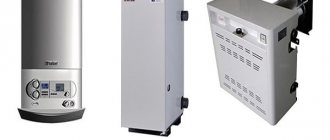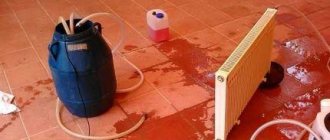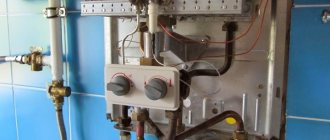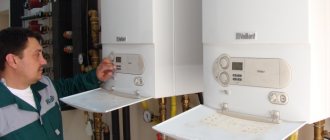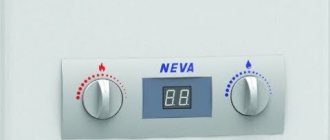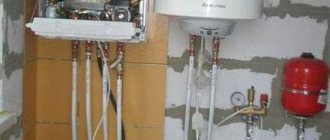Modern boilers are equipped with advanced control systems that allow the units to function normally without human intervention. This is very convenient from an ergonomic point of view, as it allows you to configure the necessary operating parameters once and never return to this point.
Automation for solid fuel boilers is distinguished by its functionality and the number of available options. The more expensive the model, the more advanced it will be and will allow you to set all operating parameters as accurately as possible. Often, expensive boilers are sold immediately together with the control unit. But you can also agree on installing non-native automation. To do this, you need to talk to the manager who will process the order.
Benefits of automatic control
Computerized control systems are being introduced into all devices. This allows them to increase their productivity and frees people from repetitive routine actions. The automation kit for a solid fuel boiler includes a main computer for control and a fan turbine. This allows you to significantly increase the efficiency of the unit, increase the efficiency of fuel combustion and minimize the loss of thermal energy during transportation.
In this case, the system will always maintain the set temperature. The boiler will not boil due to excess fuel, but the pipes will not cool either. Boiler automation helps improve burnout of wet fuel by 35%. Thus, there will be one third less unburned residues. This will allow the use of any solid waste and fossil resources as fuel.
Today, the best automation for solid fuel boilers is Atos. It is equipped with high-quality components and copes well with all technological operations. There are a large number of models on sale that are designed for boilers with different rated power.
When purchasing, it is very important to compare the technical characteristics of the automation and the boiler so that they are compatible with each other. The package includes high-precision sensors for monitoring temperatures in different compartments of the boiler. They will help maintain an optimal level of combustion, and will also allow the most efficient distribution of thermal energy throughout the system.
Features of installing automation on the boiler
The installation of automation on a solid fuel boiler should be carried out by a professional technician. The procedure has quite a few nuances that must be taken into account. Incorrect installation will make it impossible for the unit to function normally and all efforts to replace the control unit will be in vain. The cost of the service is very low, so you won’t be able to save a lot of money on this. But the damage from incorrect actions and subsequent breakdown will be noticeable.
After completing installation work, correct calibration must be carried out. You can do this yourself using the included instructions, or seek help from the specialist who carried out the installation. The automation for the boiler is configured according to the following scheme:
- 1. First, you need to fill the heating system with coolant and bleed all the air out of it so that there are no plugs that will interfere with normal circulation. It won't be difficult at all to do this.
- 2. Then you need to start the circulation pump and check that it begins to drive water through the system without any obstacles.
- 3. When the water in the system begins to circulate, you need to check the readings on all emergency thermostats, as well as the water level and its pressure in the system. All indicators must be within acceptable limits.
- 4. Now you can proceed directly to ignition. Each automation has its own characteristics of starting the flame into the combustion chamber, so at this stage you must strictly adhere to the requirements of the operating instructions.
- 5. When ignition is completed, you need to add the specified amount of fuel into the firebox and set the desired operating parameters. Occasionally you will need to add fuel and check the readings of control devices with the norm.
Ignition
I configure the combustion regulator according to this principle:
- If the system has coolant shut-off valves, you should use them, or drain the liquid from all the wiring.
- Instead of a specially designed plug, a regulator is screwed in.
- The system is filled and the burner can be ignited.
- Using the handle, you need to find the desired position corresponding to the set temperature.
- I adjust the flame to the maximum, it is advisable to achieve the appearance of a blue segment.
- Using a special valve, it is necessary to remove the yellow part of the fire.
I advise you to rely on the marks on the flywheel, because the exact readings may not be displayed on the regulator; this happens rarely, but you should not forget about this nuance. Regarding the temperature outside the window, it is also necessary to act correctly; in summer this is the area between low and average values, and in winter in the middle of the interval between average and high divisions.
Startup problems
The main excesses responsible for the mandatory adjustment of a gas boiler during start-up include excessive equipment power. Often, when selecting a burner that surpasses a small device in important indicators, problems cannot be avoided. This is due to a lack of air, which leads to the accumulation of soot in the chimney pipe, and the flame will always be yellow.
It is equally important to clean the working ventilation from contamination; if this moment is missed, then problems with draft cannot be avoided. All excess combustion products will not be removed completely, this will lead to a lack of air; by looking at the color of the fire, you can understand what’s going on. If difficulties arise with adjusting the burner flame, you should think about a defect or breakdown of the component itself; gas combustion should increase quite noticeably with a special regulator.
I noticed pressure drops very often, although this factor does not greatly affect the performance, but the chimney will gradually become clogged from fuel emissions, which will lead to incorrect operation of the unit.
What are the differences between mechanical automation and electronic automation?
Mechanical automation for solid fuel boilers is much simpler and cheaper than electronic automation. Its functionality is limited to the ability to open and close the air duct into the combustion chamber. The rate of fuel burning and the heat in the firebox will depend on this. Structurally, the product is a brass sleeve with a plastic handle and a chain that controls its movement.
The movement of the sleeve will be regulated by the temperature of the water in the system. This makes the automation completely independent of the power supply, so that in terms of reliability it is ahead of the computerized model. This type of automation can be installed independently without any problems, since it requires literally two steps.
The price of automation for a solid fuel boiler depends on its technical capabilities. The simplest mechanical models will cost 1,500 rubles. And the most “smart” automated control systems will cost more than 20 thousand rubles. But the feasibility of the purchase is undeniable, since in addition to increasing the ergonomic level of the boiler, automation also allows you to save a decent amount of money due to more efficient consumption of resources.
But today boilers have begun to be produced in more modernized ways. Now a person will not have to constantly hover around the boiler to throw in a couple of firewood or take out the ashes, nor will he have to check the temperature. The boiler does all this itself, regardless of the person, since now they have automation. This means that a person can only configure the automation as desired, and then he can not interfere with the operation of the boiler. Automation for solid fuel boilers includes a computer for control, as well as a fan turbine, which increases efficiency.
Check before first start
If the equipment is new, then there is no need to check the deposits on combustion products; it is advisable to inspect the ventilation and remove excess debris from the chimney pipe. In these elements, I often noticed the accumulation of various insects, both small and large individuals, they can affect the productivity of the unit.
Open the chimney damper to the limit and check the draft. If you carry out the manipulations as carefully as possible, problems should not arise. But it is better to do all the work sequentially and devote the required amount of time to each moment, do all the work carefully and scrupulously, because safety directly depends on this.
Advantages and disadvantages
Automation for solid fuel furnaces has a large number of advantages, and only one drawback. They will be discussed below.
So, the advantages:
- Automatic temperature adjustment. Previously, a person had to set the damper at the right level to increase and decrease the temperature in the boiler. Now, modern solid fuel stoves will take care of this themselves. A person only needs to adjust the temperature and that’s it! During operation, the boiler will check the temperature and, using special devices such as a fan or pump, will limit or increase the air supply. If the temperature inside the boiler rises, the air supply is automatically limited, and if the temperature is below the set norm, the air supply is increased.
- Independent operation of the boiler. Previously, if the owner needed to go somewhere for several days, he had to completely turn off the boiler, that is, take it out of the operating phase. With modern units everything is different. Thanks to automation, you can set the minimum parameters for the stove before leaving, and when you arrive, the house will be warm and cozy.
- Ignition of fuel. Now there is no need to ignite the fuel. The system will do this automatically.
- Safety. Modern units have the highest level of safety. The system is equipped with special devices that are capable of detecting the breakdown or failure of one or another element. This will be indicated by a sharp jump in temperature, change in pressure, etc. If this is detected, the system automatically stops operation and makes a sound, so the owner can quickly find out about the malfunction and call a specialist.
- Electricity reserve. If the power supply is suddenly interrupted, the unit will continue to operate for some time.
- Self-loading of fuel. Modern boilers have a special tank in which firewood or other types of fuel are stored. Automation is capable of automatically loading fuel into the combustion chamber. Now the ash pan is also cleaned automatically without human intervention.
- Control system. There are types of automation where a person, by clicking on special screen elements, must set certain values. But there are also options where a person does not need to approach the system and can simply control the remote control, and the signal is picked up at a fairly large distance.
These are the advantages of automation. It must be said that all this is aimed at making human life as comfortable as possible and the boiler as safe as possible. Automation has only one drawback - energy dependence.
Setting up the ignition device in a gas boiler
To set up the ignition device of a Baxi or other gas boiler, you will need a set of tools:
- Pliers.
- Screwdriver.
- Keys.
- Multimeter.
- Alcohol.
Procedure:
- Remove the terminals, short and tighten with pliers.
- Turn on the pilot burner.
- Find out the resistance using a multimeter.
- Not 1-2 Ohms? Get a new meter.
- Norm? Clean the sensor with cotton wool and alcohol.
- Put everything as it was. Check if the ignition device is working.
If these steps do not help set up the gas boiler, you need to contact the thermocouple breaker:
- Remove the terminals.
- Look at the resistance.
- Not 3 Ohms? Take the keys.
- Remove the nut on the breaker and pair.
- Unscrew the breaker (about half a circle).
- Take the insert where the contacts are and remove the breaker.
- Connect valve and pair.
- Make sure the ignition is in order.
If you can’t turn it on, it’s a problem with the pair.
And then you need to remove the fastening between the first burner and the pair, check the strength with a voltmeter. If the pair is working properly, then use alcohol to treat the contacts with the breaker.
How to supply gas when setting up a gas boiler:
- The flame lights up but quickly goes out.
- You hear a popping noise during ignition.
- The flames extend beyond the designated area.
- The fire is red or red-orange.
The fire can pass to the main burner if there is one on the pilot burner. The flame may not be supplied if the draft is weak or absent at all. When the system is automated, the user is better able to supply gas safely.
Strapping scheme
A solid fuel unit is usually connected to a boiler that runs on a different type of fuel. This is usually an electrical unit.
An electric one is installed parallel to the solid fuel stove. This is the so-called auxiliary element. Its role is as follows: if, for example, the owners are not in the house for a long time, and the solid fuel boiler has run out of fuel, then the auxiliary element, in this case, the electric unit, automatically comes into working condition. It maintains positive temperatures. More on how it all works.
First, the coolant under pressure from the circulation pump is supplied to the boiler, passing through which it heats up. Next, the coolant enters the radiator, where movement follows the principle of natural circulation. Then it enters a special boiler, inside of which there is a coil that is immersed in water. The coolant, passing through the coil, heats it, as a result of which the water heats up. Thus, the residents of the house are provided with hot water.
After the boiler, the coolant again enters the radiators and underfloor heating coils. But before that, he must pass a special crane. If the temperature of the coolant corresponds to the established norm, then the tap opens and the coolant circulates through the floor coils, and if the temperature is higher than normal, the tap closes.
Hot water priority
In the hot water priority mode, we observe a clear sequence of actions and cyclic switching on for heating. If you want to turn on one of the hot water taps, the boiler will forget about heating and begin to heat the water. This is called hot water priority.
The heating works around the clock, the boiler knows when to turn on and off, maintaining the required temperature in the house. The need for hot water is much less frequent than the need to heat a house. When you turn on the water, the house is “already warm,” but the water is “still hot.” Therefore, priority for heating hot water is higher than for heating.
In most modern gas boilers, the water temperature can be adjusted separately in the range from 35 ºC to 55 ºC. The procedure is similar to the heating procedure. Set the appropriate temperature and use hot water.
Installation. Step-by-step instruction
The installation of automation should be carried out by a professional who knows his business. This process is very complex and hides a large number of nuances that must be taken into account. There is no need to skimp on the services of an installation specialist; it is already inexpensive.
If you take on this work yourself, then there is a big risk of making mistakes, for which you will have to pay for them in material resources many times over, since you will have to replace most of the boiler elements.
- The first thing specialists usually do is install a ventilation system. It is usually installed at the bottom of the boiler, where the damper is located. First, the damper is removed, then the fan is installed. It must be secured with four fasteners.
- The next step is to install the controller. The controller is a control unit. Specialists install it in the upper part of the boiler. But it can also be installed on the side.
- Then the automation is configured. Setting up the automation will be discussed in more detail below.
- The system is then connected to a power source and tested. There may also be many other options depending on the manufacturer.
Kinds
Automation for solid fuel units can be classified according to autonomy.
There are two types here:
- Automation that does not require electricity.
- Automation powered by electricity. This type performs all its functions only if it is connected to a power source. Of course, it is also equipped with a backup reserve if the power supply is suddenly interrupted. So, even if the electricity supply is interrupted, the boiler will continue to work for some time.
Of these two options, it is the second option that is recommended, since it has a large number of diverse functions and effectively fulfills its obligations.
How to setup
As a rule, all devices have instructions from the manufacturer, which detail step-by-step instructions on how to set up a newly installed device.
In general, all steps boil down to the following points:
- First, the heating system must be filled with coolant. At the same stage, the presence of air cavities inside the system is checked. They shouldn't exist.
- Now the circulation pump is activated. Here you need to make sure that it adjusts the coolant without any obstacles.
- After the circulation pump is started, it is necessary to check the thermostat indicators, where temperature and pressure indicators will be given. All these indicators must be within the limits established in the instructions.
- If all indicators are normal, then you can start ignition. Here you should fulfill all the requirements specified in the instructions without exception, since automation devices from different manufacturers release flames into the combustion chamber in completely different ways and have a number of their own characteristics.
- When everything is completed, you should throw a certain amount of fuel into the firebox (this amount is usually indicated in the instructions) and set the necessary parameters. It is recommended to add fuel several times and check the instrument readings to ensure they do not go beyond normal limits.
Estimated cost
Different manufacturers have different prices and characteristics of automation devices.
Among domestic manufacturers, there are two companies that are quite popular in the market:
- Start. The automation of this company operates on an ATOS unit. Power reaches 40 kW. The cost of the unit is 6,000 rubles, and the cost of the temperature controller is 2,500 rubles.
- Virbel. The automation from this company costs a little less – 2,500 rubles.
Strange as it may sound, in our age of scientific and technological progress, solid fuel boilers still remain in demand and are even considered practically the most common heating devices. And if there is demand, then there will be offers - not only for the boilers themselves, but also for various devices designed to optimize their operation. One of such devices is automation for solid fuel boilers, which allows you to very effectively control the operation of the boiler, simplify its maintenance and operation. We will talk about how it works and on what principle it works in this article - in addition, together with the website stroisovety.org we will talk about how to independently automate the operation of a boiler that burns solid fuel.
Automation kit for solid fuel boilers photo
Automation for solid fuel boilers: combustion control principle
At first glance, it may seem that controlling the element of fire (even placed in a confined space) is very difficult, but in fact this is not the case. Remember what affects the combustion intensity of solid fuel - that’s it, oxygen, which is supplied to the boiler through the ash pan. Consequently, you can control the operation of the boiler by opening and closing the vent - yes, this is not very convenient and not very practical, but who says that you can’t come up with an alternative? It’s very possible - all you need to do is install an electric fan in the vent door. And people can control its rotation speed very effectively.
Thus, modern automation for a solid fuel boiler fan has the following form.
- Blower fan. As a rule, it is installed either in the blower door, or a separate hole is designed for it.
- A special controller is used to control the fan speed.
- Adequate operation of this controller is guaranteed by a thermostat, the sensor of which is mounted in the heating supply pipe.
Automation for solid fuel boiler fan photo
The required coolant temperature is set on the controller - when the water in the system heats up to the set point, the sensor is triggered and the automation turns off the fan. Oxygen stops flowing into the boiler firebox, causing the fire to die out. And, conversely, as soon as the coolant temperature drops below a certain value, the same sensor sends a signal to the controller, which starts the fan - an abundant amount of air in the firebox ignites the flame with renewed vigor. Everything is simple, and the most important thing is that the person will not forget to cover the vent, thereby bringing the boiler to a boil.
Advantages provided by an automation kit for a solid fuel boiler
There are no accidents or coincidences in our world, and people had to automate the process of burning solid fuel in a heating boiler for a reason - there are a number of good reasons for this. The most important of them is safety. Anyone who uses solid fuel to heat a home probably knows the consequences of overheating the coolant - boiling water in the boiler can even lead to an explosion with serious consequences. First of all, automatic control allows you to control exactly this moment - a person is a forgetful creature by nature, and automation works according to a program, and there is no such thing as “forgetting” for it.
Insulation of the house
Proper insulation of premises reduces operating costs for gas heating while maintaining a given temperature regime. An important indicator of the economic feasibility of thermal insulation characteristics is the payback period of the insulation system used.
Thermal insulation of a house is a very broad concept that includes a set of works to improve the thermal insulation characteristics of any building surfaces, represented by walls, floors and ceilings. Various types of materials and technologies are used in thermal insulation measures.
Insulation of the house is carried out in stages, taking into account the material used to construct the walls, floor and ceiling, as well as the type of windows and doors installed. Proper implementation of thermal insulation ensures not only the comfort of year-round living, but also significant savings in gas consumption, which is especially important in the context of regularly rising tariffs.
Automation scheme for solid fuel boilers: expanding possibilities
Man has learned best to control electricity - it is electrical signals and impulses that are used to control everything that is needed, including other equipment involved in the operation of the heating system.
- Heating circulation pump. Automatic control allows for constant and, most importantly, uniform distribution of heat throughout all rooms of the house.
- Circulation pump for domestic hot water. At a minimum, this is control of the water temperature, and at a maximum, it is supplied on a schedule, which, again, allows you to effectively manage the received heat.
- Water temperature in the boiler. The most important thing here is to prevent overheating and prevent the consequences of this.
Automation for solid fuel boilers: diagram
And that’s not all - modern automation for a solid fuel boiler can do many different things. For example, it allows you to program it, so to speak, remotely, using a GSM module. It is also possible to program the heating operation daily, daily and even hourly. By and large, correctly selected automation for a solid fuel boiler even makes it possible to integrate it into a global smart home system.
How to make simple automation with your own hands: tips and tricks
It’s not difficult to set up the simplest automatic control of a solid fuel boiler with your own hands. The most important thing here is to buy the right equipment. You understand that you will not be able to make all the necessary devices, and the equipment itself, by and large, does not cost that much. That is why, when talking about homemade automation for a solid fuel boiler, in most cases we mean buying ready-made equipment and installing it yourself. Do-it-yourself installation is quite simple, and you can imagine this whole process in the form of the following sequence of work.
- Fan installation. This is the most difficult part of the work, especially if the boiler design does not provide for automatic control. In such a situation, you will have to make a hole for air injection yourself and install a turbine on it. In principle, this is not difficult for a technically competent person - the main thing here is not to forget about the heat-resistant seal between the fan and the door, and everything else is trivial. The fan is screwed into place through pre-drilled holes in the blower door.
- Connecting the controller. There is also nothing complicated here - when purchasing an automation kit, you are buying some semblance of a construction set, which is assembled according to the scheme. No exception is the switching of wires, which, among other things, are equipped with connectors that cannot be confused.
When the automation is assembled, there is only one thing left to do - install a temperature sensor. As a rule, in almost all models of modern solid fuel boilers a special place is provided for it. If this is not available, then you can attach the sensor directly to the supply pipeline - in the simplest version, this is done using metallized heat-resistant tape. The sensor is simply wound onto the pipe.
Homemade automation for a solid fuel boiler photo
This concerns the electronic control of a solid fuel boiler. But besides this, there are also mechanical systems that regulate the intensity of fuel combustion by simply opening and closing the boiler ash door. How such automatic control works is, one might say, quite simple. A mechanical thermoelement is installed in the boiler (in a specially designated place) - when heated, the plate built into it changes its shape and configuration, which sets a special lever in motion. In turn, this lever is connected to the ash door by a cable or chain, which transmits the movement of the lever directly to the door, as a result of which it opens and closes, depending on the temperature of the coolant in the boiler.
Which automation is better for solid fuel boilers? Mechanical or electronic? Both principles of controlling fuel combustion in a boiler have their drawbacks. Electronic systems do not work without electricity - in order to ensure the operation of the boiler during power outages, you will additionally have to purchase an uninterruptible power supply unit. The mechanics often jam. In addition, the choice of one or another automation system for a solid fuel boiler can also be influenced by its cost - mechanics will cost less.

